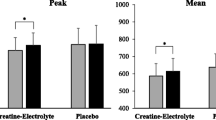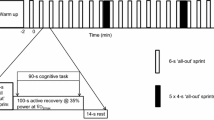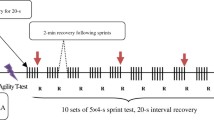Abstract
This study investigated the effects of taurine on repeated sprint exercise, performed after fixed incremental ramp exercise to exhaustion at isokinetic high (90 r/min) or low (50 r/min) cadences. In a double-blind, repeated measures design, nine females completed an incremental ramp test to volitional exhaustion, followed by 2 min active recovery and 6 × 10 s sprints on a cycle ergometer, in one of four conditions: high cadence (90 r/min) + taurine (50 mg/kg body mass); high cadence + placebo (3 mg/kg body mass maltodextrin); low cadence (50 r/min) + taurine; low cadence + placebo. Heart rate (HR) and blood lactate concentration B[La] were measured before and after the ramp test and after the sprints. Taurine lowered HR vs. placebo prior to the ramp test (P = 0.004; d = 2.1). There was an effect of condition on ramp performance (P < 0.001), with higher end-test power (d = 3.7) in taurine conditions. During repeated sprints, there was a condition × time interaction (P = 0.002), with higher peak sprint power in the placebo conditions compared to taurine (sprint 2–6; P < 0.05). B[La] was higher in taurine compared to placebo post-ramp (P = 0.004; d = 4.7). Taurine-lowered pre-exercise HR and improved incremental end-test power output, with subsequent detrimental effects on sprint performance, independent of cadence. Short endurance performance can be acutely enhanced after taurine ingestion but this effect might not be maintained across longer periods of exercise or induce the need for longer recovery periods.


Similar content being viewed by others
References
Ahlquist LE, Bassett DR, Sufit R, Nagle FJ, Thomas DP (1992) The effect of pedaling frequency on glycogen depletion rates in type I and II quadriceps muscle fibers during submaximal cycling exercise. Eur J Appl Physiol 65:360–364
Ahmadian M, Roshan VD, Ashourpore E (2017) Taurine supplementation improves functional capacity, myocardial oxygen consumption, and electrical activity in heart failure. J Diet Supp 14:422–432
Balshaw TG, Bampouras TM, Barry TJ, Sparks SA (2013) The effect of acute taurine ingestion on 3-km running performance in trained middle-distance runners. Amino Acids 44:555–561
Baum M, Weiss M (2001) The influence of a taurine containing drink on cardiac parameters before and after exercise measured by echocardiography. Amino Acids 20:75–82
Burke LM (2008) Caffeine and sports performance. Appl Physiol Nutr Metab 33:1319–1334
Cuisinier C, Ward RJ, Francaux M, Sturbois X, de Witte P (2001) Changes in plasma and urinary taurine and amino acids in runners immediately and 24 h after a marathon. Amino Acids 20:13–23
Da Silva LA, Tromm CB, Bom KF (2013) Effects of taurine supplementation following eccentric exercise in young adults. Appl Physiol Nutr Metab 39:101–104
Fitzsimons M, Dawson B, Ware D, Wilkinson A (1993) Cycling and running tests of repeated sprint ability. Aust J Sci Med Sport 25:82–87
Forbes SC, Candow DG, Little JP, Magnus C, Chilibeck PD (2007) Effect of Red Bull energy drink on repeated Wingate cycle performance and bench-press muscle endurance. Int J Sport Nutr Exerc Metab 17:433–444
Galloway SD, Talanian JL, Shoveller AK, Heigenhauser GJ, Spriet LL (2008) Seven days of oral taurine supplementation does not increase muscle taurine content or alter substrate metabolism during prolonged exercise in humans. J Appl Physiol 105:643–651
Ghandforoush-Sattari M, Mashayekhi S, Krishna CV, Thompson JP, Routledge PA (2010) Pharmacokinetics of oral taurine in healthy volunteers. J Amino Acids. https://doi.org/10.4061/2010/346237
Gwacham N, Wagner DR (2012) Acute effects of a caffeine-taurine energy drink on repeated sprint performance of American college football players. Int J Sport Nutr Exerc Metab 22:109–116
Hamilton EJ, Berg HM, Easton CJ, Bakker AJ (2006) The effect of taurine depletion on the contractile properties and fatigue in fast-twitch skeletal muscle of the mouse. Amino Acids 31:273–278
Hansen SH, Andersen ML, Birkedal H, Cornett C, Wibrand F (2006) The important role of taurine in oxidative metabolism. Adv Exp Med Biol 583:129–135
Henriksson J (1991) Effect of exercise on amino acid concentrations in skeletal muscle and plasma. J Exp Biol 160:149–165
Huxtable JR (1992) Physiological actions of taurine. Physiol Rev 72:101–163
Ishikura K, Song-Gyu Ra, Ohmori H (2013) Exercise-induced changes in amino acid levels in skeletal muscle and plasma. J Phys Fitness Sports Med 2:301–310
Ito T, Yoshikawa N, Schaffer SW, Azuma J (2014) Tissue taurine depletion alters metabolic response to exercise and reduces running capacity in mice. J Amino Acids. https://doi.org/10.1155/2014/964680
Jia F, Yue M, Chandra D, Keramidas A, Goldstein PA, Homanics GE, Harrison NL (2008) Taurine is a potent activator of extrasynaptic GABAA receptors in the thalamus. J Neurosci 28:106–115
Lang F, Busch GL, Ritter M, Volkl H, Waldegger S, Gulbins E, Haussinger D (1998) Functional significance of cell volume regulatory mechanisms. Physiol Rev 78:247–306
Lepers R, Millet GY, Maffiuletti NA (2001) Effect of cycling cadence on contractile and neural properties of knee extensors. Med Sci Sports Exerc 33:1882–1888
Matsuzaki Y, Miyazaki T, Miyakawa S, Bouscarel B, Ikegami T, Tanaka N (2002) Decreased taurine concentration in skeletal muscles after exercise for various times. Med Sci Sports Exerc 34:793–797
Milioni F, Malta Ede S, Rocha LG (2016) Acute administration of high doses of taurine does not substantially improve high-intensity running performance and the effect on maximal accumulated oxygen deficit is unclear. Appl Physiol Nutr Metab 41:498–503
Novotny MJ, Hogan PM, Paley DM, Adams RH (1991) Systolic and diastolic dysfunction of the left ventricle induced by dietary taurine deficiency in cats. Am J Physiol (Heart Circ Physiol 30) 261:H121–H127
Pincivero DM, Gandhi V, Timmons MK, Coelho AJ (2006) Quadriceps femoris electromyogram during concentric, isometric and eccentric phases of fatiguing dynamic knee extensions. J Biomech 39:246–254
Rutherford JA, Spriet LL, Stellingwerff T (2010) The effect of acute taurine ingestion on endurance performance and metabolism in well-trained cyclists. Int J Sport Nutr Exerc Metab 20:322–329
Sejersted OM, Sjogaard G (2000) Dynamics and consequences of potassium shifts in skeletal muscle and heart during exercise. Physiol Rev 80:1411–1481
Sidossis LS, Horowitz JF, Coyle EF (1992) Load and velocity of contraction influence gross and delta mechanical efficiency. Int J Sports Med 13:401–411
Ward R, Bridge CA, McNaughton LR, Sparks SA (2016) The effect of acute taurine ingestion on 4-km time trial performance in trained cyclists. Amino Acids 48:2581–2587
Warnock R, Jeffries O, Patterson S, Waldron M (2017) The effects of caffeine, taurine or caffeine–taurine co-ingestion on repeat-sprint cycling performance and physiological responses. Int J Sports Physiol Perform 24:1–24
Zhang M, Izumi I, Kagamimori S, Sokejima S, Yamagami T, Liu Z, Qi B (2004) Role of taurine supplementation to prevent exercise-induced oxidative stress in healthy young men. Amino Acids 26:203–207
Author information
Authors and Affiliations
Corresponding author
Ethics declarations
Conflict of interest
The authors declare that they have no conflict of interest.
Ethical approval
All procedures were performed in accordance with the ethical standards of the institutional and/or national research committee and with the 1964 Helsinki declaration and its later amendments or comparable ethical standards.
Informed consent
Informed consent was obtained from all individual participants included in the study
Additional information
Handling Editor: E. Rawson.
Rights and permissions
About this article
Cite this article
Waldron, M., Knight, F., Tallent, J. et al. The effects of taurine on repeat sprint cycling after low or high cadence exhaustive exercise in females. Amino Acids 50, 663–669 (2018). https://doi.org/10.1007/s00726-018-2554-2
Received:
Accepted:
Published:
Issue Date:
DOI: https://doi.org/10.1007/s00726-018-2554-2




